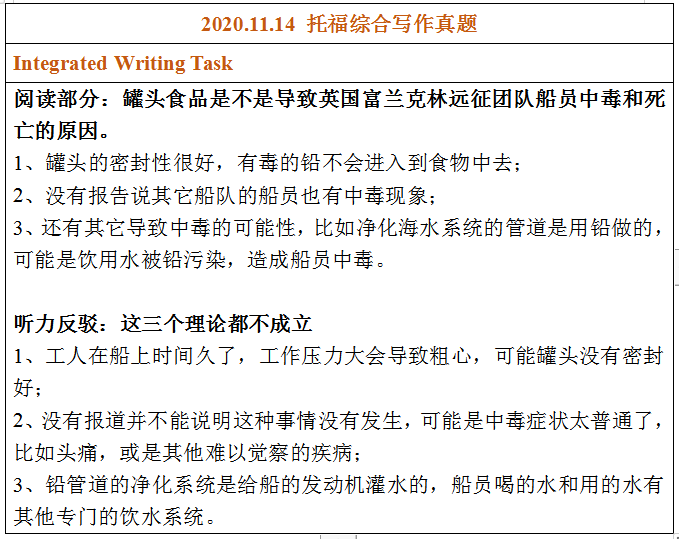

本题重复2015年12月5日以及2017年10月29综合写作真题,考察话题难度一般,属于在托福综合写作考试中考察频度中等的考古类话题,容易涉及不同领域,如建筑,化石研究和珍贵考古资料破坏等。在TPO中涉及到相关考古类话题有TPO5,TPO16,TPO26,TPO33等。希望从这些综合材料能给考生关于这类话题提供可借鉴的解题思路。
Keywords: lead, pipe, canned food, poisoning, water purification, symptoms等。
可以类比以下TPO综合写作。
TPO 26
阅读部分:
总观点:zebra mussel入侵严重危害当地鱼类
• 船会导致ZM快速占领整个北美栖息地;
• ZM繁殖力强且没有天敌,会统领新的栖息地;
• ZM会与当地鱼类争夺食物,导致鱼类数量下降。
听力反驳:
这三个理由都错误
• ZM会呆在ballast water里,如果把这个淡水倒掉换成海水,会杀死ZM;
• ZM只是一开始没有天敌,并不是永远没有天敌;
• ZM对一些鱼类也有积极影响。
TPO33
阅读部分:
总观点:关于carved stone balls的目的和含义有几种假设。
• 它们是捕猎或打斗时的武器;
• 它们属于原始称重或测量的系统;
• 有社交用途而不是实用型的。
听力反驳:
总论点:三个理由都错误
• 这些球的表面保存良好无磨损,而新时期时代的武器普遍有磨损痕迹;
• 这些球可能大小一致,但重量差异大,所以不可能用于称重。
• 很多雕刻过于简单不像是阶级象征。而且,没有哪个球是在很高社会地位的人的墓中作为个人物品发现的。

题目解析:
11月14日的独立写作重复了2015年5月24日考题。典型的政府投资类题目,需分析该投资的好处。虽然是一个同意与否题型,但题目中给出了两个比较项,即practical things和beautiful things,写作中应该注意加以对比论证。另外,在写作前应思考,两个选项分别指代哪些事物,即找出该选项的下义词,比如beautiful things包括公园,花园,艺术博物馆等;practical things包括地铁,公路等。
值得注意的是,本文题目并没有将“实用”与“美”对立,询问政府该投资“实用”还是“美”;而是“投资实用事物以外是否还要投资美的事物”。建议选择同意。构思上可以从不同角度,即分别从对人民好处和对社会好处两方进行论述。
Should the government spare a thought for things of aesthetic value when allocating financial resources? My answer is surely in the affirmative on grounds of people’s well-being and social development.
First and foremost, beautiful things soothe people’s nerves. Living in an age when competitions are taking place in all areas and at all levels, most people are exposed to a fast-paced life: children are chained to the desks in the confrontation of mounting course loads, and working adults are occupied with furthering their careers on personal time while making family the extension of their workplace. That hectic schedule is not only introducing people to growing stresses, but also, unfortunately, encroaching upon people’s private time to the detriment of their intimate relationships. It then follows that many ordinary individuals, on one hand, are struggling with pent-up feelings right while on the other hand blocking the very vent they need without realizing it. In this case, places pleasing to the eyes may provide a desirable remedy. To be specific, gardens with melodious songs of birds and fascinating views of flowers lure people into taking a walk and having a cozy chat with families; sweat-inducing climbing in a park with lively friends surely lets off steam; also, likes and comments show up on social media about pictures taken against some exotic-looking art museums or libraries help reconnect those long-lost friends, with whom people exchange news. Needless to say, spots of aesthetic value afford ideal sites for social events, thus the necessary outlets for people’s emotion and energy. In this sense, expenditure on beautifying the society is truly rewarding. By contrast, things serving practical purposes like base stations and free Wi-Fi service hardly promote people’s mood, which, in some cases, even aggravate their mental burden with information overload.
On top of that, preserving places of interests facilitates social advancement. Few would deny that historic buildings or ancient sculptures as precious cultural heritage passed down from previous generations never fail to fascinate viewers. After all, we always gravitate to our shared bond to the past, seeing it as an interesting window into the path leading all the way to our present. Thus how we’ll reap the benefits from safeguarding the historic sites will not be hard to imagine: well-maintained historical monuments and stuff like that hold constant appeal, luring visitors from all over the country even all over the globe. Coincident with the flood of travelers comes the rise in consumption, which is, in other words, burgeoning demands in things like food, souvenirs and accommodation. Then more stores or industries like restaurants, hotels, shops and travel agencies will emerge in response, with more positions created and more people hired. Hence, a ripple effect like this is believed to boost the economy to a great degree. In this way, an argument can be made that preserving unpractical while enchanting things like historic buildings is worth every penny, considering all the financial returns it’ll bring. In stark contrast, practical things like subways or hospitals, while significantly easing people’s lives, can hardly bring economic benefits as such.
From what is discussed above, the conclusion can be safely drawn that apart from practical concerns, things of aesthetic value also deserve the authority’s attention in deciding where the budget goes.